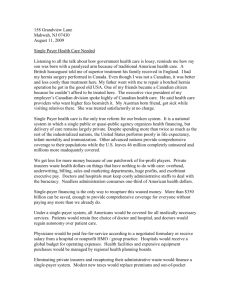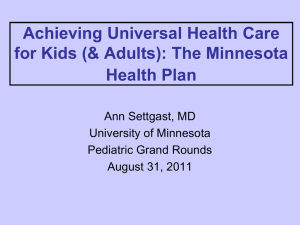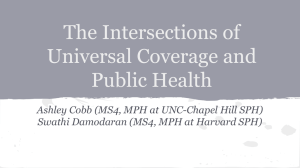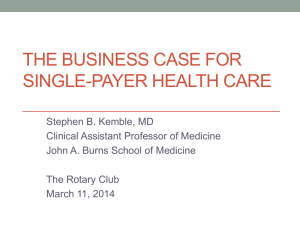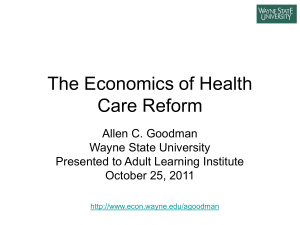UHC Presentation – UCI Fam Med Resid v7.3
advertisement
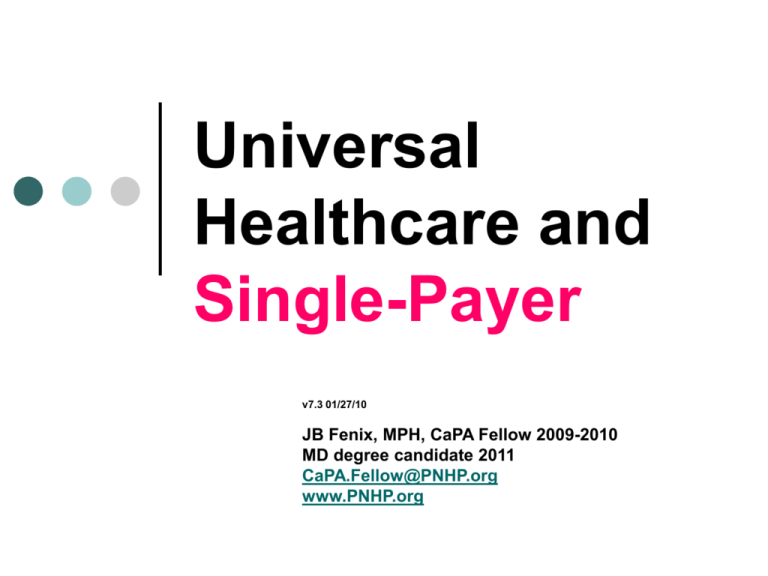
Universal Healthcare and Single-Payer v7.3 01/27/10 JB Fenix, MPH, CaPA Fellow 2009-2010 MD degree candidate 2011 CaPA.Fellow@PNHP.org www.PNHP.org Who am I? CaPA and PNHP California Physicians’ Alliance Physicians for a National Health Program http://www.PNHP.org The CaHPSA team California Health Professional Student Alliance Check out the website: http://www.CaHPSA.org/ Check out the Facebook Group (search “CaHPSA”)! Overview How this affects you! The problem. Potential solutions. Common concerns. Taking action. How this affects you! This is a moral and ethical issue! “Of all the forms of inequality, injustice in healthcare is the most shocking and inhumane.” -- Rev. Martin Luther King, Jr. We must be leaders on this issue. We have an ethical responsibility to follow the evidence and be guided by our principles. The Problem. The Problem. Poor The Outcomes. Uninsured. The Underinsured. High Costs. Mortality Amenable to Health Care: U.S. Failing to Keep Pace with Other Countries Deaths per 100,000 population* 1997/98 150 2002/03 130 99 100 76 81 88 84 89 89 97 50 65 71 71 74 74 77 80 82 109 106 84 90 116 115 93 96 134 128 115 113 97 88 82 84 101 103 103 104 110 Fr an ce Ja p Au an st ra lia Sp ai n Ita Ca ly na d No a Ne r th way er la n Sw ds ed e Gr n ee c Au e s Ge tria rm an y F Ne inl an w Ze d al De and Un nm ite d Ki ark ng do m Ire la Po nd Un r ite tug a d St l at es 0 * Countries’ age-standardized death rates before age 75; including ischemic heart disease, diabetes, stroke, and bacterial infections. Data: E. Nolte and C. M. McKee, London School of Hygiene and Tropical Medicine analysis of World Health Organization mortality files (Nolte and McKee, Health Affairs 2008). Source: Commonwealth Fund National Scorecard on U.S. Health System Performance, 2008. The Problem. Poor Outcomes. The The Uninsured. Underinsured. High Costs. The Uninsured >46 Million Uninsured in the US. >6.5 Million Uninsured in the California. •US Census Bureau Data •CHIS, 2005 The Uninsured - Toll on the Communities and the Country The diminished health and shorter life spans of Americans who lack health insurance are worth between $65 billion and $130 billion for each year spent without health insurance. Communities with high uninsured rates have reduced access to essential services and community overall health status is adversely affected. Insuring America’s Health, Institute of Medicine 2004. The Bottom Line >40,000 deaths annually due to lack of coverage Source: Wilper et al. 2009. American Journal of Public Health The Problem. Poor Outcomes. The Uninsured. The High Underinsured. Costs. The Underinsured and Barriers to Healthcare Unaffordable co-pays, and deductibles Benefits not included Rx Drugs, specialists Denial for “pre-existing conditions” Little or no ability to choose doctor Blewett et al. 2006. Medical Care Research and Review; Michael Moore. 2007. “SiCKO” % with same doctor > 5 years Lack of continuity of care amongst the Underinsured 100% 80% 60% 45% 52% 65% 65% Australia U.K. 57% 40% 20% 0% U.S. New Zealand Commonwealth Fund Survey, 1998 Canada % finding it difficult to get care Difficulty accessing care amongst the Underinsured 30 28 25 21 20 15 15 15 New Zealand Australia U.K. 15 10 5 0 U.S. Canada Commonwealth Fund Survey, 1998 The Problem. Poor Outcomes. The Uninsured. The Underinsured. High Costs. Income Growth vs Premium Growth Am Fam Physician, 72(10):2005 Where is the money going? •Unnecessary care… •Malpractice and defensive medicine… •Administrative costs… Where is the money going? Number of Administrators Growth since 1970 Number of RNs 2500% 2000% 1500% 1000% 500% 0% 1970 1975 1980 1985 1990 1995 Source: Bureau of Labor Statistics & Himmelstein/Woolhandler/Lewontin Analysis of CPS data 2001 Where is the money going? Number of Administrators Growth since 1970 Number of Physicians 2500% 2000% 1500% 1000% 500% 0% 1970 1975 1980 1985 1990 1995 2000 Source: Bureau of Labor Statistics & Himmelstein/Woolhandler/Lewontin Analysis of CPS data U.S. Overhead Spending 30% 26.5% 19.9% 20% 16.3% 10% 3.1% 0% Medicare Non-Profit Blues Commercial Carriers International Journal of Health Services 2005; 35(1): 64-90 Investor-Owned Blues But maybe?... Maybe market competition is driving towards lower costs, and better quality?... For-Profit Hospitals’ Cost More For-Profit Hospitals’ Death Rates are Higher The Unit of competition matters! Health of the patient vs. the health of the investor Potential Solutions. WWW.IOM.EDU Guiding Principles 1. 2. 3. 4. 5. Health care coverage should be universal. Health care coverage should be continuous. Health care coverage should be affordable to individuals and families. The health insurance strategy should be affordable and sustainable for society. Health care coverage should enhance health and well-being by promoting access to high quality care that is effective, efficient, safe, timely, patientcentered and equitable. Alternative Solutions Major public program extension and new tax credit. Employer mandate, premium subsidy, and individual mandate. Individual mandate and tax credit. Single-payer system. Nothing is perfect! Employer and Individual Mandate with Premium Subsidy (aka Current National Reform) Universal? Higher but not universal. Continuous? Brief gaps. Affordable? If adequate employer premium support. Dependent on employer input. Similar to status quo; possibly improved with expanded public program. Sustainable? Promotes access to high quality care? Mandate Problems. Do we want to criminalize healthcare? Will we get minimum benefit packages? Will we get maximum cost ceilings? Will insurance companies cover everyone? Tax Credits. Summed up by Stephen Colbert “It’s so simple. Most people who can’t afford health insurance are also too poor to owe taxes. But if you give them a deduction from the taxes they don’t owe, they can use the money they’re not getting back to buy the health care they can’t afford.” …maybe incremental reform is a step in the right direction? Lessons from other states… Minnesota 1992/1993 “Minnesota has set a goal of achieving universal coverage by July 1, 1997. In 1992, the state passed legislation to subsidize premiums for the uninsured and let employers buy coverage from a state pool.” “‘Minnesota is about to embark on a plan to solve the health-insurance crisis that could hold lessons for other states and the nation. It will begin to subsidize coverage for the uninsured. HealthRight will begin signing up families with children in the fall and will be fully open to Minnesota's estimated 370,000 eligible uninsured by 1994.’ Sources: New York Times 9/16/94; and Richard Reece, Medical World News 7/1/1992. Minnesota? small public plan option Tennessee 1992 Gov. Ned McWherter “Tennessee Gov. Ned McWherter unveiled a plan April 8 for what he called ‘the most radical health care plan in America’ and claimed it would become the national model. The Tennessee plan would gather nearly 1 million current Medicaid patients with 500,000 uninsured Tennesseans into a single managed care program called TennCare.” “TennCare is a five-year demonstration project that will use managed care organizations to deliver care to a million Medicaid recipients. TennCare will cover an additional 300,000 currently uninsured in the first year. The number of uninsured enrolled in the program could reach 500,000 in the second year.” Sources: Federal & State Insurance Week 4/12/93; and PR Newswire 11/19/93. Tennessee? Medicaid expansion + Public Plan Option Washington? Mandates + Medicaid Maine? Public Plan Option Massachusetts? Medicaid and medicaid-like expansions, mandates, + public plan option for those <300% poverty Most Residents of Massachusetts Affected by Health Reform Report it is Hurting Them Robert J. Blendon, et al, “Massachusetts Health Reform: A Public Perspective From Debate Through Implementation,” Health Affairs 27, no. 6 (2008): w562 (published online 28 August 2008; 10.1377/hlthaff.27.6.w556). Most Residents of Massachusetts Affected by Health Reform Report Higher Health Care Costs Robert J. Blendon, et al, “Massachusetts Health Reform: A Public Perspective From Debate Through Implementation,” Health Affairs 27, no. 6 (2008): w562 (published online 28 August 2008; 10.1377/hlthaff.27.6.w556). SINGLE-PAYER What is Single Payer? Publicly Funded Privately Delivered How Single-Payer affects you! Single-Payer will help address the primary care crisis. Under the bill (SB 810), the Commissioner is mandated to establish a budget to support the development and training of a health system workforce that is sufficient to meet the health care needs of the population. This would include assuring that adequate numbers of primary care providers were trained and available to maintain quality of care standards. Single-Payer: SB 810 Universal? Yes. Continuous? Yes. Affordable? Yes. Sustainable? Yes. Promotes access to high quality care? Yes. SB 810 Guarantees comprehensive benefits Coverage includes: Medical, dental and vision care. Prescription drug. Emergency room services, surgical and recuperative care. Emergency and other necessary transportation. Orthodontia. Mental health care and drug rehabilitation. Immunizations. Laboratory and other diagnostic services. Adult day care. All necessary translation and interpretation. Case management and skilled nursing care. Single-Payer – Affordable (This is important.) SB 810 - Affordable SAVINGS FOR FAMILIES Families with under $150,000 in annual income would, on average, see savings ranging between $600 and $3,000 per family. SAVINGS FOR BUSINESSES Employers who currently offer health benefits would realize average savings of 16% compared to the current system. SAVING FOR STATE AND LOCAL GOVERNMENTS In addition, state and local governments would save about $900 million, in the first year, in spending for health benefits provided to state and local government workers and retirees. Aggregate savings to state and local governments would be about $43.8 billion over 10 years. Source: Non-Partisan Lewin Group Report, 2005 SB 810 Saves Money By 2015, health spending in California under the Act would be about $68.9 billion less than currently projected. Total savings over a ten year period would be $343.6 billion. Source: Non-Partisan Lewin Group Report, 2005 Single-Payer - Affordable June, 1991 General Accounting Office: “If the US were to shift to a system of universal coverage and a single-payer, the savings in administrative costs [10 percent of health spending] would be more than enough to offset the expense of universal coverage.” (“Canadian Health Insurance: Lessons for the United States,” 10 pgs, ref no: T-HRD-91-35. Full text available online at http://archive.gao.gov/d20t9/144039.pdf). Single-Payer - Affordable August, 2005 -The National Coalition on Health Care: Impacts of Health Care Reform: Projections of Costs and Savings; By Kenneth E. Thorpe, Ph.D. This fiscal analysis of the impact of four scenarios for health care reform found that the single payer model would reduce costs by over $1.1 trillion over the next decade while providing comprehensive benefits to all Americans. The other scenarios would be improvements over the status quo, but would not reduce costs as dramatically or provide the same high-quality coverage to all. Single-Payer - Affordable December, 2007: Kansas Single-Payer would save $869 million: The Kansas Health Policy Authority hired the consulting firm of Schramm-Raleigh to do a fiscal analysis of five options for expanding coverage. They found that single payer (“the Mountain plan”) would cover all the uninsured and reduce state health spending by $869 million annually. The other plans would cover a portion of the uninsured and would raise costs between $150 million to $500 million in the state. (www.healthfund.org/reportspubs/11012007fdn_report_khpa.php) Single-Payer - Affordable June 2004: Single-Payer in Georgia would reduce healthcare spending A fiscal study by the Virginia-based Lewin Group found that Single-Payer health would cover all Georgia residents and save $716 million annually. Nearly all Georgia families would pay less for health care than they are today for much better coverage. Source: (The Lewin Group, Inc. “The Georgia SecureCare Program: Estimated Cost and Coverage Impacts” Final report 10/21/03) (Full text of the study available online at: http://www.pnhp.org/news/lewinanalysis.pdf) Single-Payer - Affordable November 2002: Rhode Island: Single Payer would save $270 million in Rhode Island At first, the administrative and bulk purchasing savings have the largest impact. But over time, slowing the rate of inflation to 4 percent has a larger impact. Over six years, they estimate that consolidated financing alone would save $4.4 billion, while single payer with “professionalism within a budget” delivery system reform would save over $6.6 billion. Again, both models of single-payer would provide coverage for all the uninsured and improve coverage for all Rhode Islanders. Source: (“Rhode Island Can Afford Health Care for All: A Report to the Rhode Island General Assembly” On-line at www.healthreformprogram.org. For copies of this report, please contact Alan Sager or Deborah Socolar or phone the Health Services Department at (617) 638-5042. ) Single-Payer - Affordable October 2003: Missouri Single-Payer would save $1.3 billion in Missouri Missouri Foundation for Health conducted a study on “health care expenditures and insurance in Missouri”: A single payer health care plan in the state of Missouri would reduce overall spending by about $3 billion. “Even if the state would adopt a benefit package-one more generous than 75 percent of all private insurance benefits in the state-overall spending would decline.” Source: ( “A Universal Health Care Plan for Missouri”, the full report can viewed athttp://www.mffh.org/ShowMe3.pdf) Single-Payer – Affordable: So what does this mean? For more data on affordability: http://www.pnhp.org/facts/single_payer_system_cost.php?page=all The evidence is strong. Cost directly impacts affordability for families and individuals. Cost directly impacts long-term sustainability for the program as a whole. If it isn’t affordable and sustainable it isn’t feasible! Feasibility – But we’ll never get political support… The State Option and the California Example Political Support AFSCME District Council 36 - 5/11/09 AFSCME Local 57 – 5/1/09 AFSCME Local 444 – 5/8/09 AFSCME Local 955 – 5/6/09 AFSCME Local 2019 – 5/6/09 AFSCME Local 2428 – 5/7/09 AFSCME Retirees Chapter 36 – 3/16/09 Alameda-Contra Costa Transit District – 4/21/09 Alliance for Democracy, Mendocino Coast – 4/11/09 AP Goodyear Construction – 4/13/09 ACLU, Southern California – 4/2/09 American Association of University Women American Association of University Women, Pasadena Branch American Federation of State, County and Municipal Employees (AFSCME) –4/8/09 American Medical Students Association, National - 3/25/09 American Medical Students Association, Davis School of Medicine chapter -3/27/09 American Medical Students Association, UCLA Pre-medical Chapter 5/6/09 Bay Area Veterans of the Civil Rights Movement - 3/22/09 California Alliance for Retired Americans - 4/13/09 California Chiropractic Association (if amended) – 4/30/09 California Commission on the Status of Women – 4/7/09 County Health Executives Association of California – 3/26/09 Democratic Party of Contra Costa County – 5/21/09 Diablo Valley Democratic Club – 3/19/09 Political Support California Communities United Institute – 3/9/09 California Health Professional Student Alliance – 5/21/09 California Federation of Teachers – 4/7/09 California Foundation for Independent Living Centers – 4/24/09 California Labor Federation, AFL-CIO – 4/6/09 California Nurses Association/National Nurses Organizing Committee – 3/24/09 California Pan-Ethnic Health Network – 4/21/09 California Physicians Alliance – 4/10/09 California Professional Firefighters – 3/23/09 California Retired Teachers Association – 4/14/09 California School Employees Association – 3/20/09 California Senior Coalition – 5/25/09 California Society for Clinical Social Work - 4/9/09 California Student Physicians for Healthcare Reform – 4/10/09 California Teachers Association – 4/7/09 Church of Christ the Saviour, Orthodox Church of America, San Francisco –4/13/09 Church of St. John the Baptist, El Cerrito – 5/22/09 City of Albany – 4/13/09 City of Berkeley – 4/21/09 City of El Cerrito – 4/7/09 City of San Pablo – 3/31/09 City of Santa Monica – 4/15/09 Coalition of Lavender-Americans on Smoking and Health (CLASH) – 5/7/09 Coastside Democrats – 5/24/09 Committees of Correspondence – 3/31/09 Concerned Citizens of Laguna Woods Village 5/15/09 Consumer Federation of California – 3/25/09 Contra Costa County Advisory Council on Aging – 5/22/09 Political Support East Bay Peace Action – 5/26/09 Easter Hill United Methodist Church – 3/31/09 El Cerrito Democratic Club – 4/7/09 Elsdon, Inc., small business – 4/2/09 Evergreen Democratic Club – 5/8/09 Federation of Retired Union Members of Santa Clara County – 4/15/09 Glendale City Employees Association – 4/1/09 Having Our Say – 4/8/09 Health Access of California – 3/24/09 Health Care for All – California – 3/9/09 Health Officers Association of California – 4/29/09 Hubert Humphrey Democratic Club – 5/4/09 International Alliance Theatrical Stage Employees Local 33 – 4/19/09 International Association of Machinists – 4/9/09 The Kennedy Club of San Joaquin – 4/5/09 Labor Task Force for Universal Health Care - 4/20/09 Lamorinda Peace and Justice Group – 4/3/09 League of Women Voters, Diablo Valley – 4/13/09 League of Women Voters, El Dorado County – 4/3/09 Leagues of Women Voters, Oakland - 5/12/09 League of Women Voters, San Diego County – 4/21/09 League of Women Voters, San Joaquin County – 4/1/09 League of Women Voters, San Jose/Santa Clara -4/1/09 League of Women Voters, Southwest Santa Clara Valley – 5/6/09 Political Support Los Angeles Unified School District – 4/8/09 Lumina Media Productions (Richmond, CA) – 3/4/09 Manteca Democratic Club – 3/9/09 Marin County Board of Supervisors – 4/20/09 National Association of Social Workers, California chapter – 4/23/09 National Council of Jewish Women, Long Beach – 4/12/09 North Richmond Municipal Advisory Council – 5/12/09 Officescapes, Newport Beach, CA – 4/11/09 Old Lesbians Organizing for Change – 4/12/09 Older Women’s League of California – 4/13/09 Older Women’s League – San Francisco Chapter - 1/13/09 Organization of SMUD Employees – 4/1/09 Promotores de Salud of Behavioral Health Services 5/13/09 Rainbow Coalition, West Contra Costa – 3/24/09 Richmond Commission on Aging 12/5/08 San Bernardino Public Employees Association – 4/1/09 San Fernando Valley Interfaith Council – 3/18/09 San Francisco Tobacco Free Coalition – 5/4/09 San Jose Peace and Justice Center – 4/29/09 San Luis Obispo County Employees Association – 4/1/09 Santa Monica Community College District – 5/4/09 Santa Rosa City Employees Association – 4/1/09 Service Employees International Union – 4/7/09 St. John of God Catholic Church, San Francisco – 4/8/09 Students of University of CA Program in Medical Education (PRIME) – 3/1/09 Political Support – Just the Co-Authors! Elaine Alquist (principal) Gil Cedillo Ellen Corbett Mark DeSaulnier Dean Florez Loni Hancock Alan Lowenthal Alex Padilla Fran Pavley Gloria Romero Darrell Steinberg Patricia Wiggins Leland Yee District 13 District 22 District 10 District 7 District 16 District 9 District 27 District 20 District 23 District 24 District 6 District 2 District 8 San Jose Los Angeles San Leandro Walnut Creek Bakersfield, Fresno Oakland Long Beach Van Nuys Santa Monica Los Angeles Sacramento Santa Rosa San Francisco Political Support – Just the Co-Authors! Tom Ammiano Karen Bass Jim Beall Marty Block Bob Blumenfield Julia Brownley Wes Chesbro Joe Coto Mike Davis Hector De La Torre Mike Eng Noreen Evans Mike Feuer Mary Hayashi Jared Huffman Dave Jones District 13 District 47 District 24 District 78 District 40 District 41 District 1 District 23 District 48 District 50 District 49 District 7 District 42 District 18 District 6 District 9 San Francisco Los Angeles San Jose Lemon Grove Van Nuys Woodland Hills Eureka, Santa Rosa, Ukiah San Jose Los Angeles South Gate Monterey Park Santa Rosa, Napa, Vallejo West Hollywood Hayward San Rafael, Santa Rosa Sacramento Political Support – Just the Co-Authors! Ted Lieu Bonnie Lowenthal Fiona Ma Tony Mendoza Pedro Nava Curren Price Ira Ruskin Mary Salas Nancy Skinner Jose Solorio Sandré Swanson Tom Torlakson Alberto Torrico Mariko Yamada District 53 District 54 District 12 District 56 District 35 District 51 District 21 District 79 District 14 District 69 District 16 District 11 District 20 District 8 El Segundo Long Beach San Francisco Norwalk Santa Barbara, Oxnard Inglewood Los Altos Chula Vista Oakland Anaheim Oakland Martinez Fremont Vacaville Taking Action. Your support matters! Educate. Educate yourself: • http://www.PNHP.org/news/ • http://healthreform.kff.org/ Educate others: Help me get speakers to other residency programs! Advocate. Contact your State Senator for Floor Vote Tomorrow! • Find your Senator: votesmart.org Join our OC Leg visit team Grow. Help improve the PNHP LA Chapter Help develop the District Leader Network Join PNHP! Questions? How this affects you! The problem. Potential solutions. Common concerns. Taking action. THANK YOU! CaPA.Fellow@PNHP.org www.PNHP.org EXTRA SLIDES How this affects you! How reform affects you! Healthcare reform will dramatically change how we practice medicine. We have a responsibility to defend our patients and our professions; if we don’t take the lead then others will! How Single-Payer affects you! Single-Payer will help address the primary care crisis. Under the bill (SB 810), the Commissioner is mandated to establish a budget to support the development and training of a health system workforce that is sufficient to meet the health care needs of the population. This would include assuring that adequate numbers of primary care providers were trained and available to maintain quality of care standards. How Single-Payer affects you! Single-Payer will eliminate the role of insurance companies in making healthcare decisions. Decision making will be returned to healthcare providers and their patients. Single-Payer would end uncompensated medical care by guaranteeing everyone has access to a payer. The Uninsured Source: Fronstin, Paul. 2002. Sources of Health Insurance: Analysis of the March 2002 Current Population Survey. Issue Brief 252. Washington, DC: Employee Benefit Research Institute; Mills, Robert, and Bhandari, Shailesh. 2003. Health Insurance Coverage in the United States: 2002. P60-223. Washington, DC: U.S. Census Bureau. And who will financial hardship effect disproportionately?! … The Problem. Poor Outcomes. The Uninsured. The Underinsured. High Costs. Inequality. Racial Disparity in Access to Kidney Transplants Vermont? Oregon? Mandates + Medicaid expansion Massachusetts 2006, Medicaid and medicaid-like expansions, mandates, + public plan option for those <300% poverty “Every uninsured citizen in Massachusetts will soon have affordable health insurance and the costs of health care will be reduced. Gov. Romney.” “The bill does what health experts say no other state has been able to do: provide a mechanism for all of its citizens to obtain health insurance.” Sources: Wall Street Journal 4/11/06 and New York Times 4/5/06. “You Can’t Cross a Chasm in Small Steps” – David Lloyd George Single-Payer - Affordable December 2002: Maine Single-Payer an economically feasible option for Maine. “In summary, a single-payer system appears to be economically feasible for Maine.” Source: (Mathematica Policy Research, Inc, “Feasibility of a Single-Payer Health Plan Model for the State of Maine” Final report 12/24/03/, MPR Ref No: 8889-300, 80 pages.http://www.mathematicampr.com/PDFs/mainefeasibility.pdf) But, but, but… This just isn’t feasible!... Feasibility – But healthcare providers will never support this… Feasibility – But other people will never support this… The Uninsured More than 80% of uninsured children and adults live in working families. More than 80% are US citizens. •Kaiser Family Foundation, 2004 Common Fears. Common Fears. Fear #1: Fear #2: Socialized medicine and increased taxes Rationing and long waiting times Fear #3: It will ruin our system Fear #1: Socialized medicine and taxes TRUTH: It’s cheaper! Total Health Expenditure per Capita in US $ 7000 TRUTH: It Guarantees choice! Under SB 810, all consumers have complete freedom to choose their healthcare providers. No more restrictive HMO networks. Delivery of care remains as it is; a competitive mix of public and private providers. 6000 5000 US $ 2003 4000 2004 3000 2005 2000 1000 0 Canada France Germany Japan Sweden Major Industrial Countires Source: OECD, 2006 United Kingdom United States Fear #2: Rationing and wait times TRUTH: We already have rationing and wait times! TRUTH: SB 810 has specific provisions to insure that the demand for healthcare providers and resources is met in a comprehensive and systematic manner. Source: Business Week, June 2007; Commonwealth Fund; Fear #3: It will ruin our system Quality of Care Slightly Better in Canada Than U.S. A Meta-Analysis of Patients Treated for Same Illnesses (U.S. Studies Included Mostly Insured Patients) Source: Guyatt et al, Open Medicine, April 19, 2007 Variation in Medicare Spending: Some Regions Already Spend at Canadian Level Public Program Extension and Tax Credit Universal? No. Continuous? Gaps in coverage. Affordable? Somewhat. Sustainable? Not during difficult economic times. Similar to status quo. Promotes access to high quality care? Individual Mandate and Tax Credit Universal? Unlikely. Continuous? Brief gaps. Affordable? Not for the older, less healthy, and those in expensive areas. Unlikely. Sustainable? Promotes access to high Similar to status quo. quality care? SB 810 Security - Everyone is covered Choice - Everyone can choose their doctors and other providers. Health care delivery is in the private sector. Comprehensive Benefits - Everyone has full benefits. High Quality - Doctors and patients, not administrators, make medical decisions. Efficient Administration - Huge savings result from removing insurance companies from health care. Provider and patient paper work is slashed. Fair Reimbursement - Providers receive fair and full compensation for their services.
